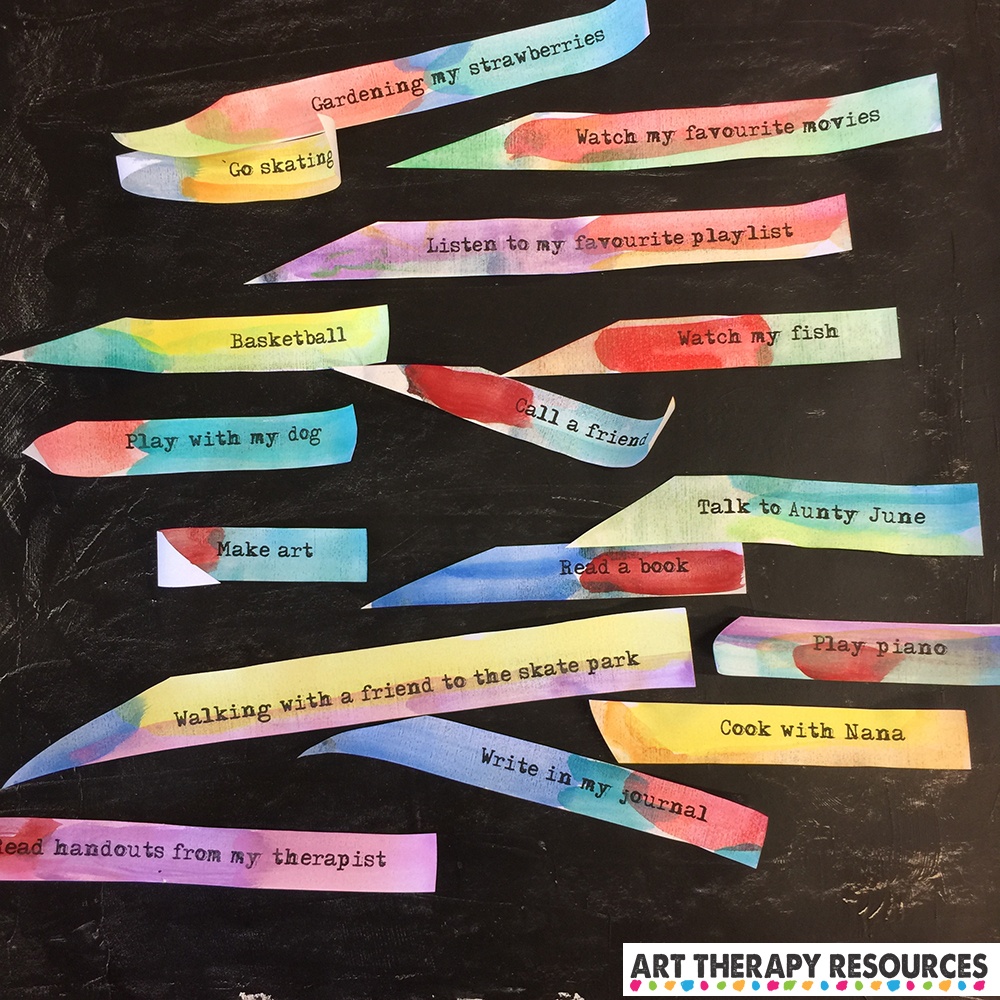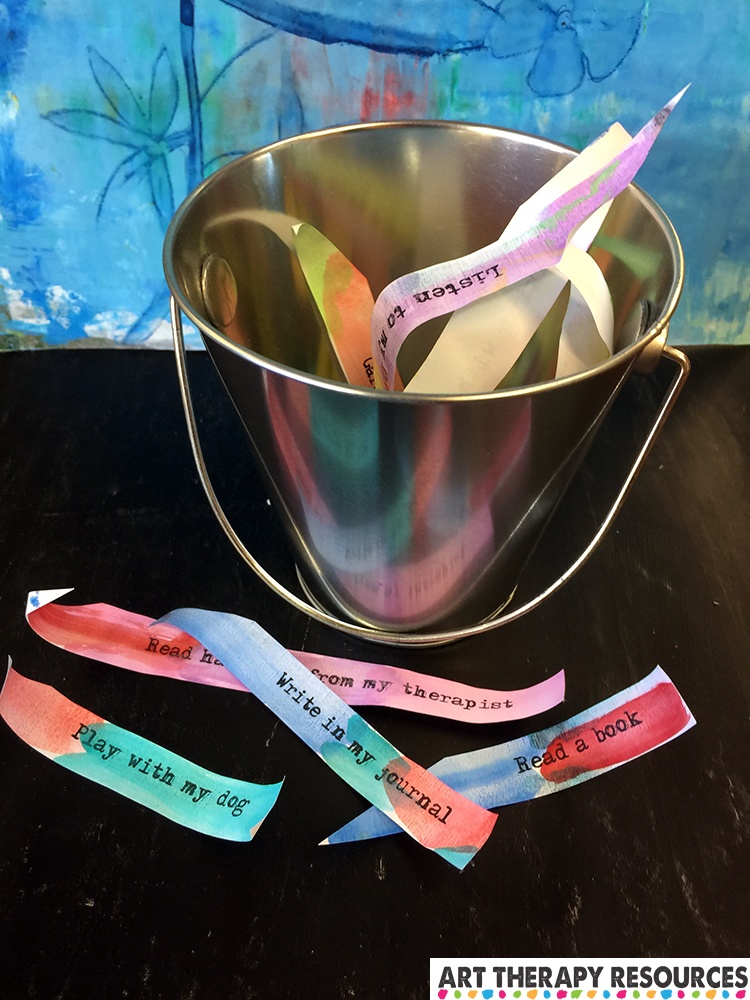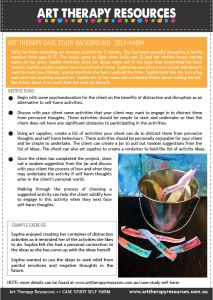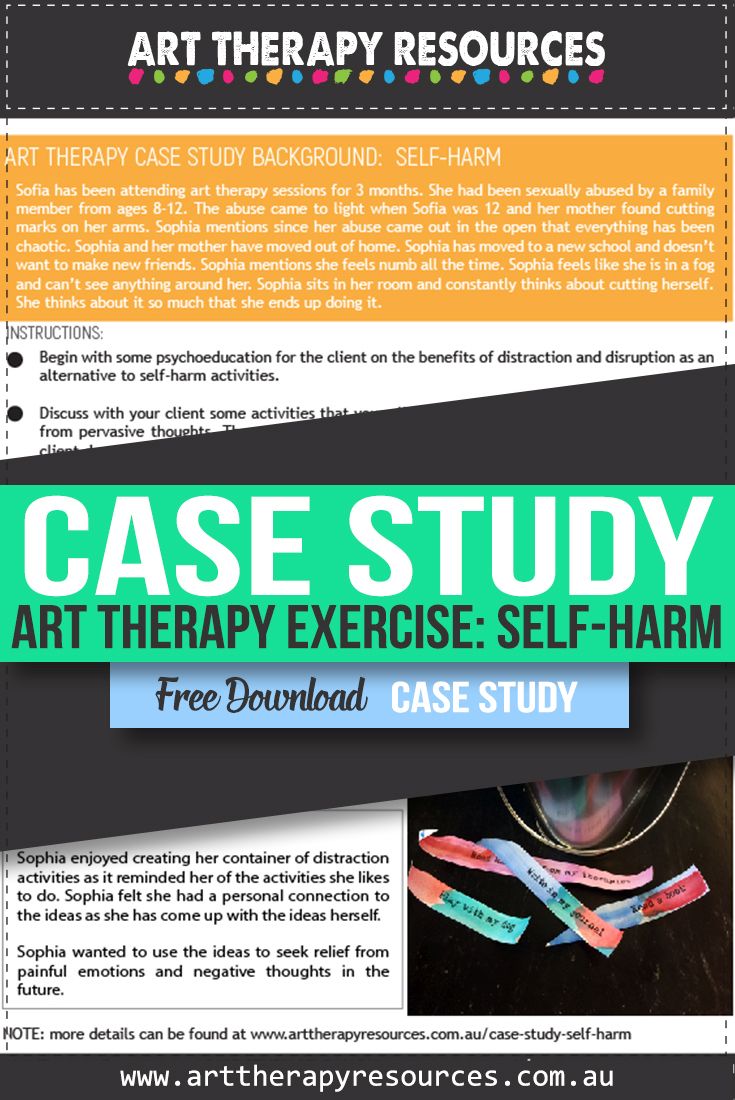THIS POST INCLUDES:
- Art Therapy and Self-harm
- About the Client
- Current Client Issues
- Art Therapy Exercise
- Client Insight and Outcomes
- Disclaimer
- FREE DOWNLOAD Art Therapy Exercise
ART THERAPY AND SELF-HARM
Self-harm refers to the act of self-injury to seek relief from psychological and emotional distress.
Self-harming often begins in adolescence and can continue for many years. The most common methods of self-harm include overdose of alcohol or drugs, cutting, hair pulling, bruising, burning, and biting.
Self-harm is not always clinically viewed as suicidal intent but is often used as a coping mechanism for strong emotions that feel overwhelming. Often, individuals will experience a feeling of release, however, they may also experience guilt and shame which in turn creates more emotional distress and confusion.
Research indicates that self-harm may be repeated numerous times as a coping mechanism. Self-harm may escalate to intended suicide which is twice as likely to occur amongst males.
Self-harm can have a debilitating effect on a person’s physical health due to the damage done on organs by overdose, as well as nerve and tendon damage done by external self-harm activities. Some people may be left with permanent disfigurement as a consequence of self-harm actions.
WHY DO PEOPLE SELF-HARM
Many people who self-harm suggest that the actions of self-harming provides a release to overwhelming emotions. They state that talk therapy often doesn’t provide an outlet for the intense emotions that they carry and the action of self-injury can often provide an immediate remedy to painful thoughts and emotions. For many, self-harm injuries become a tangible account of their internal struggles.
Self-harm can also be inflicted as a distraction process where the individual is more focused on their self-injury and away from their real emotional pain that relates to other circumstances and experiences.
People who self-harm may have internalised anger that is exacerbated by anxiety and depression. The anger is often manifested through self-injury behaviour as an expression of self-destructive behaviour. Furthermore, some people who self-harm explain that their psychological pain creates a numb feeling where they feel their personality has been crushed to a state of death. The act of self-harm is sometimes used by a person to shake themselves ‘awake’ and out of the feeling of numbness.
Like many behavioural processes, people can become trapped within a cycle of emotional numbness followed by acts of self-harm to violently awaken the self to feel something again.
Self-harm is often present in the adolescent demographics as a result of limited verbal expression for what may be complex emotional life experiences.
The prevalence of self-harm has increased amongst refugees and asylum seekers in recent years, especially those who have been held in detention over a period of time and have lost hope of their circumstances changing.
HOW ART THERAPY CAN HELP WITH SELF-HARM
Self-harm is often viewed as an outward expression of the internal experience of individuals. Art therapy can be used as an alternative for this outward expression. Clients can engage in art therapy as a process of creative expression through the process of building tangible forms of personally held thoughts and emotions. Clients can also use art to break down negatively held views and dismantle internally stored pain through the art techniques that involve destructive acts of tearing, cutting, destroying, as well as reforming and transforming previously created art.
Art therapy can broaden an individual’s toolbox for coping with negative experiences and developing new ways to understand the emotions that surface through difficult experiences. Through art therapy, individuals are also validated and supported by an art therapist through this process.
It’s important to remember as a therapist that the therapeutic relationship is an integral part of helping clients who self-harm. Therapists can foster a safe and open environment for the client to seek help and feel supported despite their self-harm behaviours which often draws judgment from other relationships that the client may have.
TANGIBLE EXPRESSION OF PAIN
Art therapy provides an ideal opportunity for clients who self-harm to redirect their self-harm actions towards a creative and tangible expression of their emotional pain. Clients can use colours, patterns, shapes, and textures to translate fears, pain and other emotions into visual representations.
Through the process of creating art, clients can record their journey of progress which gives further tangible reference of how the client has coped with their emotional experience.
Art therapy can also help clients develop a sense of internal ownership, purpose, and control by providing clients with the skills to creatively express what they feel cannot be spoken. Through creating art, clients are also able to develop creative skills and learn problem solving skills that can be adapted to other problems in the client’s life.
COPING MECHANISM
Art therapy can be used effectively as a distraction away from self-harm and become a more useful container for coping with painful emotions. The client can create artwork that translates the pain, or the client can create art that introduces positive imagery that can combat the negative imagery they are holding inside.
Art therapy can also provide clients with art exercises that focus on the meditative aspect of creativity and help the client develop coping methods to help them reduce feelings of distress and encourage mindfulness and a sense of calm.
BENEFITS OF ART THERAPY
Art therapy can help clients who self-harm by introducing some of the below goals as part of treatment:
- Connecting with the present moment by creating art
- Identifying emotions through art expression
- Distraction techniques through art activities
- Thought disruption techniques through art activities
- Relaxation, stress reduction and self-soothing through mindful art activities
- Developing problem-solving skills through art activities
ADDITIONAL RESOURCES
If you’re looking for additional resources to help supplement this content about chronic illness and art therapy, we sell many products in our store that can be used to help clients address the various aspects of coping with a chronic illness. These include:
- Art Therapy Guidebook – Developing Mindfulness
- Art Therapy Guidebook – Developing Motivation
- Art Therapy Guidebook – Developing Resilience
- Art Therapy Guidebook – Developing the Self
- Anxiety Workbook – 6 Week Program
You may also want to read some of our previous blog posts to read more case studies listed below:
- 10 Art Therapy Exercises for Anxiety
- Case Study: Using Art Therapy for a Client with a Stress-related Disorder
- Case Study: Using Art Therapy for a Client with Alcohol Addiction
- Case Study: Using Art Therapy for a Client with Anxiety (GAD)
- Case Study: Using Art Therapy for a Client with Borderline Personality Disorder
- Case Study: Using Art Therapy for a Client with Depression
- Case Study: Using Art Therapy for a Client with PTSD
ABOUT THE CLIENT
- Name: Sofia
- Age: 13
- Summary of sessions to date: Sofia has been attending art therapy sessions for 3 months. She had been sexually abused by a family member from ages 8-12. The abuse came to light when Sofia was 12 and her mother found cutting marks on her arms.
CURRENT CLIENT ISSUES
Sophia mentions since her abuse came out in the open that everything has been chaotic. Sophia and her mother have moved out of home. Sophia has moved to a new school and doesn’t want to make new friends. Sophia mentions she feels numb all the time. Sophia feels like she is in a fog and can’t see anything around her. Sophia sits in her room and constantly thinks about cutting herself. She thinks about it so much that she ends up doing it.
ART THERAPY EXERCISE
This art therapy exercise is to help clients explore alternative coping mechanisms for the emotional pain that surfaces. Clients may feel that their current method of coping through self-harm is the only method available. While deeper psychoanalysis is important for treatment, clients can also learn distraction techniques to help disrupt pervasive negative thinking that may lead to destructive self-harm behaviour.
INSTRUCTIONS:
- Begin with some psychoeducation for the client on the benefits of distraction and disruption as an alternative to self-harm activities.
- Discuss with your client some activities that your client may want to engage in to distract them from pervasive thoughts. These activities should be simple to start and undertake so that the client does not have any significant obstacles to participating in the activities.
- Using art supplies, create a list of activities your client can do to distract them from pervasive thoughts and self-harm behaviours. These activities should be personally enjoyable for your client and be simple to undertake. The client can create a jar to pull out random suggestions from the list of ideas. This can include creating a jar or box to contain the ideas. Some ideas include:
- Physical activities -walking, sport, gardening.
- Positive mental health activities – journaling, meditation, reading positive mental health literature.
- Activities to develop positive emotions – listen, watch, read to positive songs, movies, books etc to encourage joy, laughing, love, and other positive emotions.
- Connecting with positive relationships – spending time with friends, family, mentors, pets.
- Seeking positive inspiration in movies, songs, quotes, books, images etc.
- Art activities – creating a mandala, free flow exploration of colours, shapes, patterns
- Use art supplies to create a container to hold the list of activity ideas.
- Once the client has completed the project, draw out a random suggestion from the jar and discuss with your client the process of how and when they may undertake the activity if self-harm thoughts arise in the client’s personal world. Walking through the process of choosing a suggested activity can help the client solidify how to engage in this activity when they next face self-harm thoughts.
CLIENT INSIGHT AND OUTCOMES
Sophia enjoyed creating her jar of distraction activities and decided to call her jar a ‘Jar of Relief’. Sophia felt she had a personal connection to the jar and ideas as she has come up with the ideas. Sophia wanted to use the jar to seek relief from painful emotions and negative thoughts in the future.


DISCLAIMER
This case study represents a snapshot of the client’s progress in treatment. The exercise in this article could be used as written or as a guide for new and original tasks developed by the Art Therapist. Responsibility for treatment resides with the individual therapist who understands their clients specific needs. The art therapy exercise should not be viewed as a pre-defined directive on how to treat a client that presents with a specific range of problems.This art therapy exercise will help build a database of knowledge to draw upon when helping your client. Art Therapy is associated with psychotherapy techniques, however each therapist often approaches therapy with their own foundation of psychological interventions, whether it be psychotherapy, CBT, DBT or other methods.
FREE DOWNLOAD: Art Therapy Exercise
Download the FREE Art Therapy Exercise based on the above Case Study. The free download includes instructions for the art therapy exercise, along with an example of the art therapy exercise.

BUILD YOUR ART THERAPY REFERENCE MATERIALS:
Pin this image to your Pinterest board.

SHARE KNOWLEDGE & PASS IT ON:
If you’ve enjoyed this post, please share it on Facebook, Twitter, Pinterest. Thank you!
